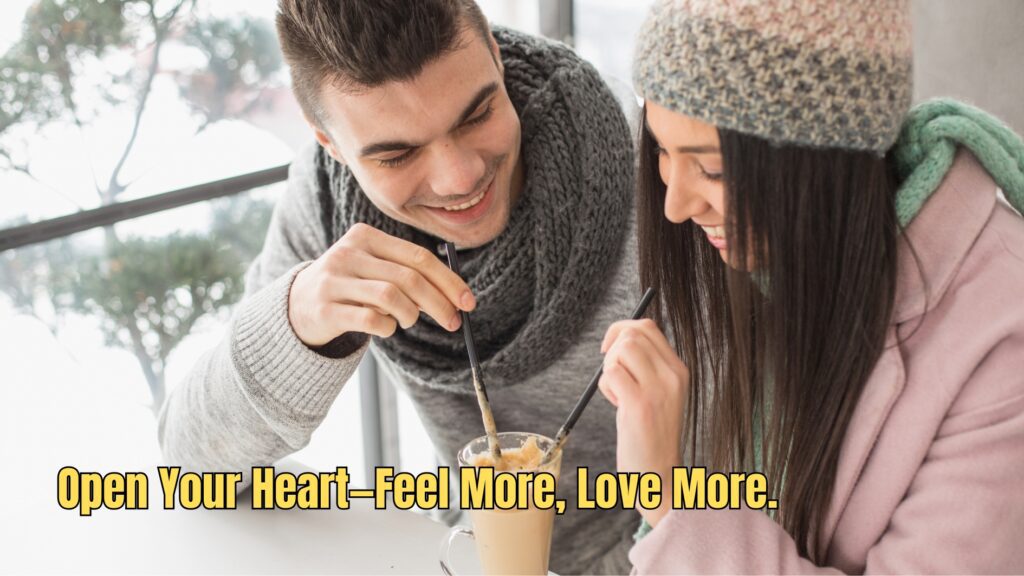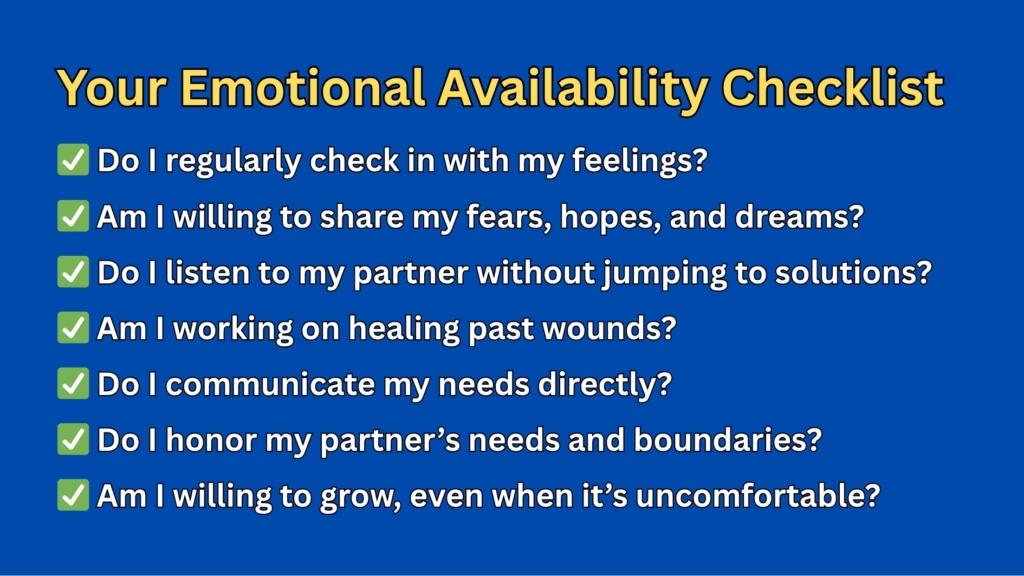Emotional availability is the cornerstone of truly fulfilling relationships, yet so many of us struggle to understand what it means or how to achieve it. From fleeting flings to lifelong partnerships, our ability to be emotionally present determines the depth of our connections. In this article, we’ll dive into what emotional availability looks like, why it’s crucial, and—most importantly—six proven ways to nurture it within yourself. Let’s unlock the hidden doors of your heart and discover the power of genuine connection.

What is Emotional Availability?
At its core, emotional availability means being open, receptive, and willing to share your feelings—both the joyous and the vulnerable ones. It’s about being present with your partner (or even yourself) and having the courage to connect on a deeper level.
👉 Real-life Example:
Take Emily and Jake, a couple in their mid-30s. On the surface, they seemed perfect—great jobs, cute apartment, all smiles on social media. But behind closed doors, Emily felt like Jake was always “there” physically, but never truly present. He’d listen with half an ear, avoid hard conversations, and brush off her concerns. In therapy, they discovered that Jake’s fear of vulnerability was keeping him from being emotionally available—until he worked through it and learned to really show up in their relationship.
Why is Emotional Availability So Important?
When you’re emotionally available, you:
-
-
Build trust and safety in your relationship.
-
Strengthen communication and reduce misunderstandings.
-
Create space for deeper intimacy and connection.
-
Feel more seen, heard, and valued.
-
Conversely, emotional unavailability can lead to:
-
-
Constant misunderstandings and miscommunications.
-
Feelings of loneliness, even when you’re together.
-
Emotional distance and eventual breakdown of trust.
-
6 Ways to Open Your Heart and Cultivate Emotional Availability
1️⃣ Practice Self-Awareness
The first step to emotional availability is understanding your own feelings. Many of us operate on autopilot, ignoring the emotional undercurrents that shape our words and actions.
👉 Practical Tip:
Try daily journaling. Write about how you’re feeling without censorship. Over time, you’ll spot patterns—triggers, fears, desires—that reveal your emotional landscape.
👉 Expert Insight:
Dr. Brene Brown, renowned for her work on vulnerability, says:
“When we have the courage to own our stories, we get to write a brave new ending.”
(Read more from Dr. Brown on vulnerability and emotional connection here: Brene Brown’s Website)
2️⃣ Embrace Vulnerability
Vulnerability is the lifeblood of emotional availability. It’s about sharing your true self—flaws, fears, and all.
👉 Real-life Example:
Sarah, a 28-year-old teacher, shared with her boyfriend how her parents’ messy divorce left her scared of commitment. Instead of shutting down, he listened and reassured her. That conversation strengthened their bond immeasurably.
👉 Recent Research:
A 2024 study published in the Journal of Social and Personal Relationships found that couples who shared vulnerabilities reported 45% higher relationship satisfaction than those who didn’t.
3️⃣ Listen Without Judgment
Emotional availability isn’t just about what you share—it’s also about how you listen.
👉 Checklist for Active Listening:
✅ Put down your phone and give your partner your full attention.
✅ Reflect back what you hear to show understanding.
✅ Resist the urge to “fix” their feelings—sometimes, listening is enough.
👉 Case Study:
In a couples’ retreat in Bali, a group of partners practiced “mirroring”—repeating back what their partner said before responding. This simple technique led to breakthroughs in empathy and closeness.
4️⃣ Heal Old Wounds
Unresolved past hurts—like betrayals, family drama, or heartbreak—can block emotional availability.
👉 Practical Example:
If you’re still carrying pain from an old relationship, consider talking with a therapist or trusted friend. Healing those wounds can free you to be more open in the present.
👉 Expert Interview:
Dr. John Gottman, relationship researcher, emphasizes:
“Unhealed injuries from past relationships can become emotional walls in new ones.”
(Check out his insights at The Gottman Institute)
5️⃣ Communicate Your Needs Clearly
If you’re emotionally available but your partner isn’t sure what you need, you’ll still feel disconnected.
👉 Example:
Instead of saying, “You never care about my feelings,” try:
“I feel really alone when you’re scrolling your phone during dinner. Can we try putting them away for mealtime?”
This direct, vulnerable language fosters connection instead of defensiveness.
6️⃣ Set Healthy Boundaries
Boundaries aren’t walls—they’re bridges. Clear boundaries help you feel safe, respected, and emotionally available.
👉 Checklist for Boundaries:
✅ Identify your dealbreakers (e.g., honesty, loyalty).
✅ Speak them gently but firmly.
✅ Honor your partner’s boundaries as well.
👉 Practical Example:
Emma, a 34-year-old writer, realized she was emotionally available to everyone except herself. She learned to say “no” to draining conversations and protect her energy, making her more present with her partner.
Emotional Availability: A Quick Comparison
| Aspect | Emotionally Available | Emotionally Unavailable |
|---|---|---|
| Communication style | Open, vulnerable, honest | Guarded, dismissive, vague |
| Response to conflict | Seeks understanding, shares feelings | Avoids or shuts down |
| Presence | Fully engaged, truly listening | Distracted, disconnected |
| Impact on intimacy | Deepens closeness and trust | Creates distance and resentment |
| Long-term relationship health | Builds resilience and partnership | Erodes connection and satisfaction |
Use this checklist as a gentle guide to become more emotionally available and build richer connections.
Real-Life Case Studies
Case Study 1: Breaking Down Emotional Walls
Liam, 42, had always been “the strong, silent type.” But his marriage was falling apart. Through couples therapy, he realized he’d been hiding behind stoicism, afraid to be seen as “weak.” When he finally shared his fears with his wife, it brought them closer than they’d been in years.
Case Study 2: Emotional Availability After Heartbreak
Nina, 29, felt shut down after a painful breakup. She worked with a therapist to process her grief and learned to trust her emotions again. Now, in a new relationship, she’s experiencing a level of connection she never imagined possible.
Special Advice for You
Emotional availability isn’t a finish line—it’s a journey. Give yourself permission to take small steps. Celebrate every vulnerable moment, every time you choose to listen instead of defend. You’re not just improving your relationship—you’re rewriting your emotional story.
Conclusion: The Power of Emotional Availability
When you’re emotionally available, you unlock a new dimension of love. It’s messy, it’s raw, but it’s real.
Remember: being open doesn’t mean being perfect—it means being human, and inviting someone else to join you in that beautiful, imperfect humanity.
Call to Action
Ready to explore your emotional availability?
👉 Share this article with someone you trust—a partner, a friend, or even yourself.
👉 Leave a comment about your experiences with emotional availability—your story might inspire someone else.
👉 Subscribe to our newsletter for weekly tips on deepening your emotional connection and living your most authentic life.
FAQs About Emotional Availability
Q1.What does emotional availability really mean?
It means being present, open, and willing to connect emotionally with another person. It’s about sharing your feelings and listening to theirs.
Q2.Can emotional availability be learned?
Yes! It’s a skill you can build with practice, self-awareness, and support from people who care.
If you avoid deep conversations, shut down during conflict, or feel numb when others open up, you may be emotionally unavailable.
Q4.Can past trauma affect emotional availability?
Absolutely. Trauma can create fear of intimacy or vulnerability, but healing is possible with self-compassion and, if needed, therapy.
Q5.Does emotional availability change over time?
Yes, it can! As you grow and heal, you may find yourself more open and willing to connect deeply.
Q6.Why is vulnerability so important in relationships?
Vulnerability builds trust and intimacy. It’s how we show our real selves and invite others to do the same.
Q7.What if my partner isn’t emotionally available?
Have an honest, gentle conversation. Let them know how it feels and see if they’re willing to grow together.
Q8.Are there exercises to become more emotionally available?
Yes—journaling, active listening, and sharing your feelings with trusted people are great places to start.
Q9.Is emotional availability only important in romantic relationships?
No! It’s crucial in friendships, family relationships, and even how you relate to yourself.
Q10.How can I stay emotionally available if I’m afraid of rejection?
Remember: rejection doesn’t define your worth. Start small, be patient with yourself, and know that real connection is worth the risk.
Useful Articles :-
- Signs of Love Bombing: 7 Red Flags to Spot Manipulative Affection Early
- What Is a Situationship? 7 Unfiltered Truths About Modern Love
- 10 Signs of a Healthy Relationship: What To Look For
- Communication Skills for Couples: 7 Transformative Tips to Strengthen Your Connection
- 7 Powerful Ways to Build Healthy Relationship Boundaries for Lasting Love
- 9 Empowering Steps for Recovering from a Breakup: Heal, Grow, and Thrive
- 7 Powerful Long-Distance Relationship Advice : Tips to Keep the Spark Alive
- Jealousy in Relationships: 7 Powerful Ways to Manage the Green-Eyed Monster
- 5 Insights Into Love Languages in Relationships : Do They Really Work?
- What Does Emotional Safety In Relationships? 7 Biblical Keys to Building Trust and Intimacy
